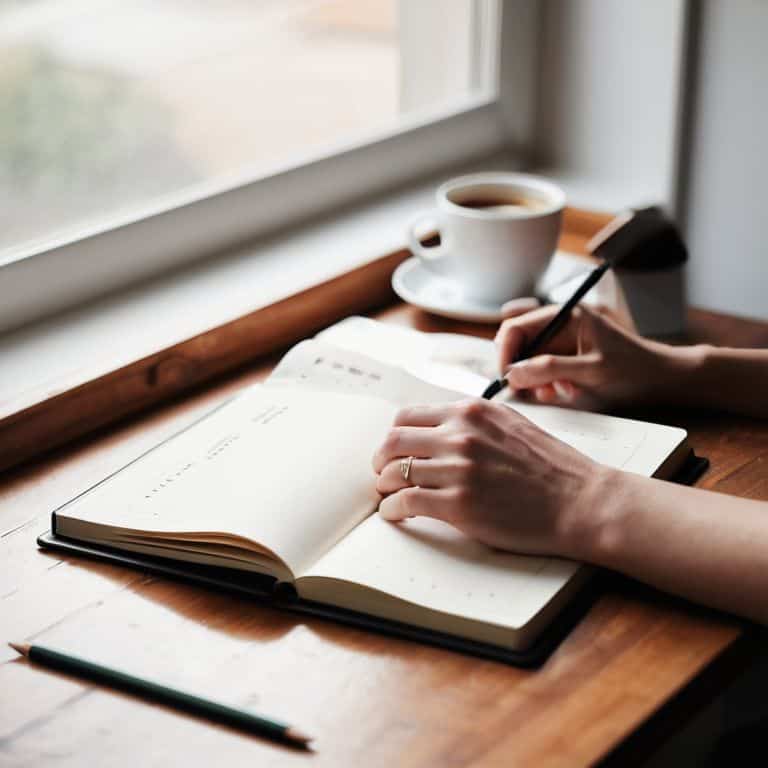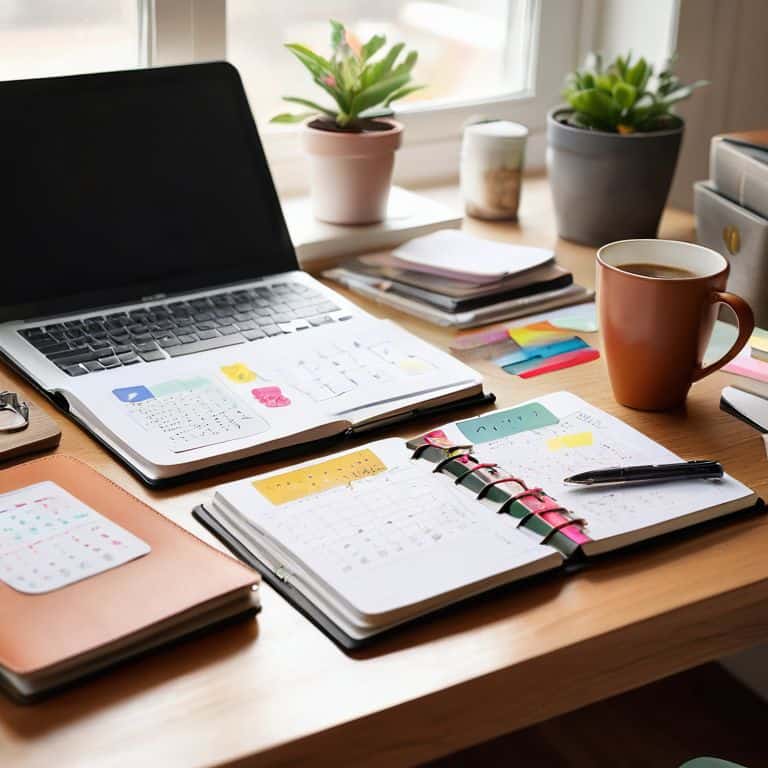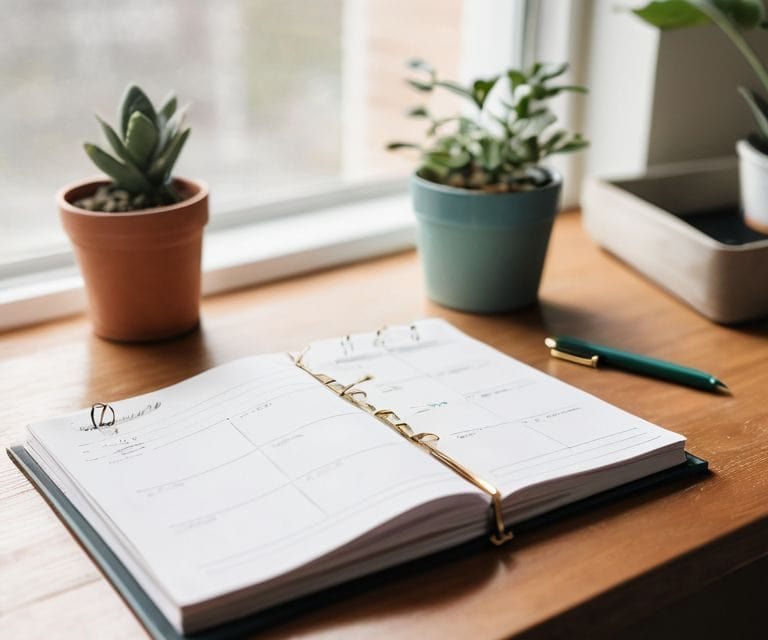I still remember the day I thought using a planner to achieve your goals was just about writing down a bunch of to-do lists and waiting for magic to happen. But let me tell you, it wasn’t until I started using my planner in a way that actually made sense for my chaotic, creative life that things started to fall into place. I was tired of feeling like I was stuck in a never-ending cycle of hustle and burnout, and I knew I needed to find a better way to manage my time and energy. That’s when I discovered the power of a well-designed planner – not just as a tool for keeping track of appointments and deadlines, but as a key to unlocking my productivity and creativity.
In this article, I’ll share my honest, no-hype advice on how to use a planner to achieve your goals, without sacrificing your sanity or creativity. You’ll learn how to create a personalized system that works for you, not against you, and how to avoid common pitfalls like over-planning and burnout. I’ll give you the lowdown on how to set realistic goals and break them down into manageable, bite-sized tasks, and how to use your planner to stay focused and motivated, even when the going gets tough. By the end of this guide, you’ll be equipped with the knowledge and tools you need to start using your planner in a way that truly supports your goals and well-being.
Table of Contents
- Guide Overview: What You'll Need
- Step-by-Step Instructions
- Using a Planner to Achieve Your Goals
- 5 Game-Changing Tips to Supercharge Your Planner
- Getting Real About Planner Productivity: 3 Key Takeaways
- Planning for Success
- Putting it All Together: Your Path to Planner Success
- Frequently Asked Questions
Guide Overview: What You'll Need

Total Time: 1 hour 30 minutes
Estimated Cost: $10 – $30
Difficulty Level: Easy
Tools Required
- Pen (fine-tip or medium-tip)
- Pencil (for drafting or sketching)
- Eraser (for correcting mistakes)
Supplies & Materials
- Planner (daily, weekly, or monthly format)
- Stickers or colorful pens (optional, for decoration or emphasis)
- Goal-setting workbook (optional, for additional guidance)
Step-by-Step Instructions
- 1. First, let’s talk about setting up your planner for success – this means choosing a planner that actually works for you, not just one that looks pretty on your Instagram feed. I mean, think about it, if you’re a morning person, you’ll want a planner that has a daily schedule starting from, say, 6 am. On the other hand, if you’re a night owl, you might want one that starts later in the day. The key is to find a planner that fits your lifestyle, not the other way around.
- 2. Next, you need to define your goals – and I don’t mean just scribbling down some vague ideas like “be more productive” or “make more money.” I’m talking about getting specific and concrete. What exactly do you want to achieve? By when? And what steps do you need to take to get there? Write it all down in your planner, and make sure it’s something you can measure and track over time.
- 3. Now it’s time to break down those big goals into smaller, manageable tasks. This is where most people get stuck, but trust me, it’s a total game-changer. Take each of your big goals and ask yourself, “What’s the smallest, most doable step I can take today to move closer to achieving this?” Write down that step in your planner, and then take it. Repeat this process every day, and watch how those small steps add up over time.
- 4. The next step is to schedule your tasks in your planner. This means taking those small, doable steps you broke down earlier and assigning them to specific days and times. Be realistic about how long each task will take, and don’t overload yourself with too much to do in one day. Remember, the goal is to make progress, not to set yourself up for burnout.
- 5. As you start using your planner, it’s essential to track your progress. This means regularly reviewing what you’ve accomplished, what’s still pending, and what needs to be adjusted. Use stickers, colors, or whatever system works for you to mark off completed tasks and celebrate your wins. And don’t be too hard on yourself when you miss a day or two – just get back on track and keep moving forward.
- 6. Another crucial step is to review and adjust your planner regularly. This could be weekly, monthly, or quarterly, depending on your needs and preferences. The idea is to take a step back, evaluate what’s working and what’s not, and make intentional changes to your system. Ask yourself, “Is this planner still serving me?” or “Do I need to switch to a different system?” Be open to trying new things and evolving your approach as needed.
- 7. Finally, remember that consistency is key when it comes to using a planner effectively. It’s not about being perfect; it’s about showing up every day and making progress. Don’t get discouraged if you miss a day or two – just get back to it and keep moving forward. And hey, if you need a little motivation, treat yourself to a great cup of coffee and remind yourself why you started using a planner in the first place: to achieve your goals and live a more intentional life.
Using a Planner to Achieve Your Goals

As I sit here with my trusty planner, I’m reminded that customizing your planner for success is key to making it a habit. For me, that means adding a dash of color with stickers to highlight important tasks and deadlines. It’s a small touch, but it makes the process of planning feel more enjoyable and helps me stay motivated. When it comes to setting realistic daily goals, I like to break them down into smaller, manageable tasks that can be spread throughout the day.
I’ve tried various planner layouts for productivity, but I’ve found that a simple, straightforward approach works best for me. I use a combination of daily and weekly spreads to stay on top of my tasks and appointments. It’s also important to review progress in your planner regularly, whether that’s daily, weekly, or monthly, to see what’s working and what areas need improvement. This helps me adjust my strategy and make adjustments as needed.
One thing I’ve learned is that planner sizes and formats can make a big difference in how effective it is for you. I prefer a smaller planner that I can easily toss into my bag, but some people swear by larger formats or even planner apps for digital organization. The key is to find a system that works for you and stick to it. By experimenting with different layouts and tools, you can find a planner system that helps you stay organized and focused on your goals.
Customizing Planner Layouts for Productivity
Customizing your planner layout is where the magic happens. I’m a big believer in making your planner a reflection of your unique needs and style. For me, that means dedicating a spread to my weekly running schedule and another to meal planning for the recipes I want to try. Experiment with different layouts until you find one that flows with your daily routine. Don’t be afraid to add stickers, washi tape, or even hand-drawn doodles to make it visually appealing and fun to use.
I’ve found that having a “brain dump” page for noting random ideas and a separate section for tracking progress towards my long-term goals helps me stay focused. Remember, your planner should be a tool that serves you, not the other way around. So, don’t be too hard on yourself if it takes a few tries to get it just right – the key is to create a system that you actually enjoy using.
Reviewing Progress With Stickers and Realistic Goals
Now that we’ve covered customizing your planner for maximum productivity, let’s talk about reviewing progress. I’m a big fan of using stickers to mark off completed tasks – it’s a small thing, but it’s amazing how much of a motivation boost it can give you. The key is to set realistic goals for yourself, too. Don’t try to cram too much into one day or week, or you’ll just end up feeling overwhelmed and defeated. Break your bigger goals down into smaller, manageable chunks, and celebrate each tiny win along the way. Trust me, it makes all the difference.
5 Game-Changing Tips to Supercharge Your Planner
- Set realistic, achievable goals that align with your values, and break them down into smaller, manageable tasks to avoid feeling overwhelmed
- Create a ‘stop doing’ list to identify time-wasting activities that derail your focus, and replace them with habits that nourish your mind, body, and soul
- Schedule self-care and downtime in your planner, because a burnt-out you is not going to crush those goals – trust me, I’ve been there
- Use your planner to track your progress, not just your to-do lists – celebrate your wins, no matter how small, and learn from your setbacks to adjust your strategy
- Make your planner a reflection of your personality, with colors, stickers, and layouts that bring you joy and make you want to use it every day – it’s not just a tool, it’s a trusted companion on your journey to success
Getting Real About Planner Productivity: 3 Key Takeaways
Planners are not a one-size-fits-all solution – it’s all about finding a system that works for you and your unique goals, whether that’s a sleek digital app or a colorful paper notebook
Customizing your planner layout is crucial, but don’t overcomplicate it – focus on creating a simple, intuitive design that makes you excited to plan and review your progress each day
Remember, the real magic happens when you combine your planner with a healthy dose of self-compassion and realistic goal-setting – ditch the perfectionism, and celebrate small wins along the way, like finally mastering that one tricky recipe or completing a tough run
Planning for Success
A planner is not just a tool, it’s a promise to yourself that you’re worth the time and effort it takes to get your life together, one page at a time.
Jenna Sullivan
Putting it All Together: Your Path to Planner Success

As we’ve explored throughout this guide, using a planner to achieve your goals is all about finding a system that truly works for you. We’ve covered the main steps to get started, from setting up your planner to customizing layouts for maximum productivity. We’ve also talked about the importance of reviewing progress, whether that’s through stickers, realistic goals, or a combination of both. The key is to remain flexible and willing to adjust your approach as needed. By doing so, you’ll be able to stay on track, celebrate your successes, and learn from your setbacks.
So, as you close this guide and embark on your planner journey, remember that the ultimate goal is to create a life you love. It’s not just about checking boxes or filling out pages; it’s about using your planner as a tool to cultivate intention and purpose. Don’t be too hard on yourself if you miss a day or two – simply get back on track and keep moving forward. With time and practice, you’ll find that your planner becomes an indispensable companion, helping you navigate life’s twists and turns with clarity, confidence, and a sense of direction. Happy planning!
Frequently Asked Questions
How do I choose the right planner size and layout for my specific needs and goals?
Honestly, choosing the right planner size and layout is all about knowing your workflow. Do you need space for daily to-do lists or just a weekly overview? Consider your goals: are you a list-maker or a mind-mapper? I personally swear by A5-sized planners for their perfect balance of portability and writing space.
What are some creative ways to use stickers and other visual aids to track progress and stay motivated in my planner?
Honestly, I’m obsessed with using stickers to track progress – it’s like a fun reward! Try using different colors for various tasks or goals, and don’t be afraid to get creative with washi tape and doodles too. It’s all about making your planner a reflection of your personality and style.
Can I really achieve my long-term goals just by using a planner, or are there other habits or tools that I should be incorporating into my daily routine?
Honestly, a planner is just the starting point. To really crush your long-term goals, you’ll want to combine it with habits like regular reflection, accountability, and self-care. Think of it as a toolbox – your planner is one essential tool, but you’ll also want to add in things like a morning routine, exercise, and unplugged downtime to really make progress.
